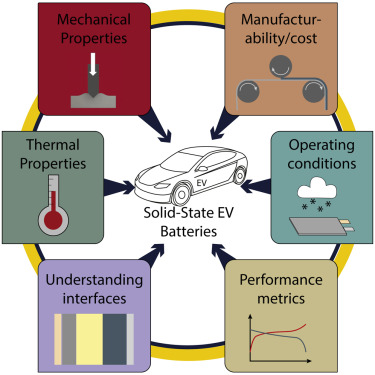Jun
2
University of Michigan researchers are asking key questions about the promising power storage in a Lithium Metal battery that need to be answered before it can make the jump from the laboratory to manufacturing facilities. The next generation of electric vehicle batteries, with greater range and improved safety, could be emerging in the form solid-state technology of a lithium metal technology.
With efforts to bring electric vehicles to a larger part of the population, the researchers said, those questions need answering quickly.
Jeff Sakamoto and Neil Dasgupta, U-M associate professors of mechanical engineering, have been leading researchers on lithium metal, solid-state batteries over the past decade. In a perspective piece in the journal Joule, Sakamoto and Dasgupta lay out the main questions facing the technology. To develop the questions, they worked in close collaboration with leaders in the auto industry.

Graphical illustration about questions and considerations for automotive battery technology. Image Credit: University of Michigan. Click image for the largest view.
Major automakers are going all-in on electric vehicles this year, with many announcing plans to phase out internal-combustion engine cars in the coming years. Lithium-ion batteries enabled the earliest EVs and they remain the most common power supply for the latest models coming off assembly lines.
Those lithium-ion batteries are approaching their peak performance in terms of the EV range on a single charge. And they come with the need for a heavy and bulky battery management system – without which there is risk of onboard fires. By utilizing lithium metal for the battery anode along with a ceramic for the electrolyte, researchers have demonstrated the potential for doubling EV range for the same size battery while dramatically reducing the potential for fires.
Sakamoto said, “Tremendous progress in advancing lithium metal solid-state batteries was made over the last decade. However, several challenges remain on the path to commercializing the technology, especially for EVs.”
Questions that need to be answered to capitalize on that potential include:
1. How can we produce ceramics, which are brittle, in the massive, paper-thin sheets lithium metal batteries require?
2. Do lithium metal batteries’ use of ceramics, which require energy to heat them up to more than 2,000° Fahrenheit during manufacturing, offset their environmental benefits in electric vehicles?
3. Can both the ceramics and the process used to manufacture them be adapted to account for defects, such as cracking, in a way that does not force battery manufacturers and automakers to drastically revamp their operations?
4. A lithium metal solid-state battery would not require the heavy and bulky battery management system that lithium-ion batteries need to maintain durability and reduce the risk of fire. How will the reduction in mass and volume of the battery management system – or its removal altogether – affect performance and durability in a solid-state battery?
5. The lithium metal needs to be in constant contact with the ceramic electrolyte, meaning additional hardware is needed to apply pressure to maintain contact. What will the added hardware mean for battery pack performance?
Sakamoto, who has his own startup company focused on lithium metal solid-state batteries, says the technology is having a moment right now. But the enthusiasm driving the moment, he says, must not get ahead of itself.
This post is illustrative for many readers wondering about lots of technologies we’ve visited in posts over the years. The press releases at this level of interest are seldom, practically never, full and complete disclosure documents and we shouldn’t expect such far reaching extremes. Process engineers have to be better than 99.999% certain there is a profit to be made before millions, tens of millions or hundreds of millions of $$ are put at risk.
There is a huge gain from lithium metal over lithium ion technology. One can fairly expect that every possible effort is being made to get a competitive lithium metal battery process worked out. If it can be done, it will get done. Then we have to wonder, where all that lithium is going to come from?
Comments
1 Comment so far


“Then we have to wonder, where all that lithium is going to come from?”
Scientists have cost-effectively harvested lithium from seawater
https://electrek.co/2021/06/04/scientists-have-cost-effectively-harvested-lithium-from-seawater/